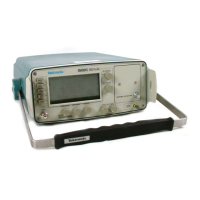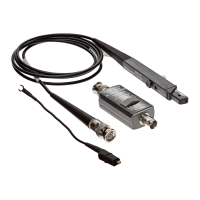Circuit Descriptions
5–6
1502C MTDR Service Manual
Integrated circuit U1010 is a pulse-width modulator switching regulator controller.
It oscillates at approximately 70 kHz and provides drive pulses to switching
transistors Q1010 and Q1011. The output pulses from these transistors are filtered
to DC by flyback rectifier CR2010, choke L1010, and capacitors C2010 and C2012.
The resulting +16.6 VDC is fed back to the regulator U1010 by voltage divider
R1016 and R1015. It is then compared to a +2.5 VDC reference voltage from,
U1011. To increase the output voltage, U1010 increases the pulse width of the drive
to Q1010 and Q1011. To reduce the output voltage, U1010 decreases the pulse width
to Q1010 and Q1011. This assures that a constant +16.6 VDC is maintained.
Resistor R1010 acts as a current sensing shunt in the pre-regulator return line. In the
event that a circuit fault draws excess current, the voltage developed across R1010
(and filtered by R1011, R1012, and C1011) will cause U1010 to reduce the pulse
width of the pre-regulator. This protects the pre-regulator from damage due to
overload.
The battery charger consists of a linear regulator integrated circuit, U2010, and
associated components. U2010 is connected as a current source, drawing current
from the +15.8 VDC and supplying it to the battery through T2012. The voltage
drop across T2012 is fed back to U2010 through diode CR2014 to control charging
current at a nominal 150 mA. Diode CR2013 and voltage divider R2010 and R2011
provide a voltage clamp to U2010’s feedback terminal to limit the maximum voltage
that can be applied to the battery through CR2015. As the voltage R2012 and
CR2015 approaches the clamp voltage, battery charging current is gradually
reduced to trickle charge.
Rectifier CR2015 prevents battery discharge through the charger when AC line
voltage is not present. Rectifier CR2012 allows the battery to power the instrument
when AC power is not present.
Pre-regulator or battery voltage is applied to Q2011 and Q2012 when the instrument
power switch is pulled on. The rising voltage causes Q2011 and Q2012 to turn on
due to the momentary low gate voltage while C2011 is charging. During this time,
voltage comparator U1020A compares the switched voltage to a +2.5 VDC
reference from U1022. If the voltage is greater than +9.7 VDC, U1020A turns on,
drawing current through Q2010 and R2015 to keep the gates of Q2011 and Q2012
near ground and the transistors turned on. If the voltage is less than +9.7 VDC (or
drops to that value later), U1020A and Q2010 turn off, allowing C2011 to charge
to the input voltage and turn off Q2011 and Q2012. When turned off, the deep
discharge protection circuit limits current drawn from the battery to only a few
microamperes.
The post-regulator receives from +9.7 to +15.5 VDC and boosts it to +16.2 VDC
by switching Q2022 on and off with a pulse-width modulated signal. When Q2022
is turned on, input voltage is applied across choke L2020, causing the current in
L2020 to increase. When Q2022 is turned off, the stored energy in L2020 will cause
Battery Charger
Deep Discharge
Protection
Post-Regulator
Artisan Technology Group - Quality Instrumentation ... Guaranteed | (888) 88-SOURCE | www.artisantg.com

